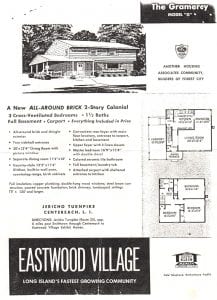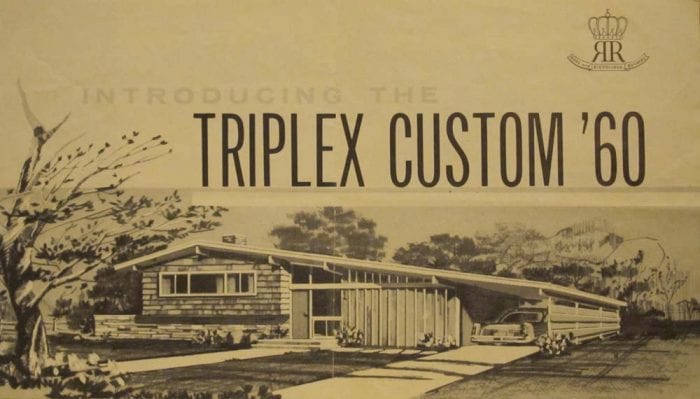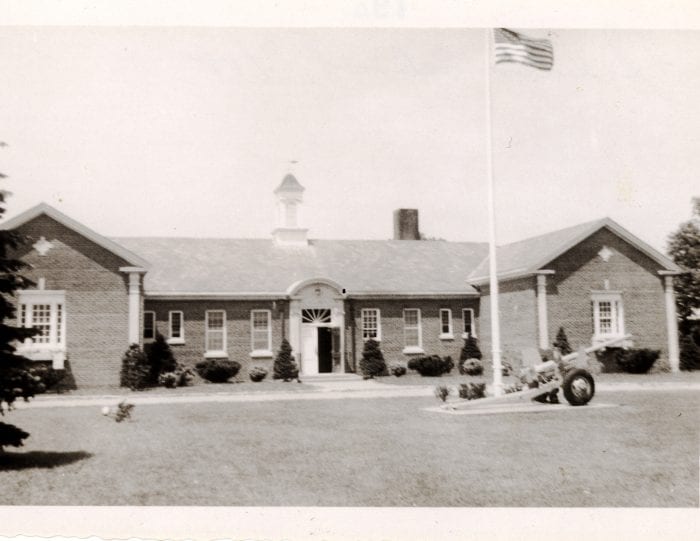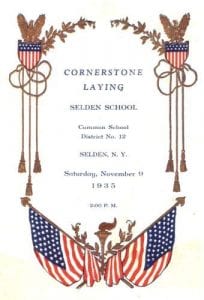Amongst the Middle Country Public Library’s many historical artifacts are a few that explain just how far the area has come from its pastoral roots. The picture and story below comes courtesy of a collaborative effort among the librarian staff.
Over the years, a variety of land developers purchased acreage in the Centereach area even as far back as 1896, despite its distance from New York City.
It took until the 1940s and 1950s for construction to begin in earnest.
Shortly after WWII, the Ulrich family developed Cedarwood Park on the north side of Middle Country Road in the vicinity of Elliot Avenue, Lake Grove. Roads were put in and building lots surveyed and improved. The lots sold for $250 each with a down payment of just $10.
The rural landscape of Centereach began to change dramatically in the middle of the 20th century when the Kaplan firm began to build low-priced homes in a development named Dawn Estates. Homes in this development sold for $7,000.
While the Kaplan brothers were among the first developers, the Krinsky Organization followed them with an even larger project. Fifteen hundred homes were to be built on a 400-acre site, but there were concerns about this project from the start.
 Doubters cited its remote location and the difficulty of obtaining necessary public utilities in what was considered an isolated area. These worries were soon overcome when the Krinsky Organization created its own water company with the capacity to serve 10,000 families.
Doubters cited its remote location and the difficulty of obtaining necessary public utilities in what was considered an isolated area. These worries were soon overcome when the Krinsky Organization created its own water company with the capacity to serve 10,000 families.
In addition, the Long Island Lighting Company agreed to extend its gas lines more than six miles beyond the existing distribution limit, bringing in electricity to serve the new homes.
On Sept. 6, 1953, the front page of the New York Times real estate section featured a picture of the new Eastwood Village exhibit home with its raised-hearth fireplace and its combination living-dining-kitchen area.
While the first year’s sales were slow, within five years 1,250 homes had been sold. The prices for these homes ranged from $9,990 to $13,500.
In 1954, Eastwood Village became a multiple builder venture as other builders erected models on already improved building sites. By 1958, 2,500 homes had been sold in the development. Due to expanding job opportunities and the availability of larger houses on bigger sites, increasing numbers of people flocked to the area.
A study by Klein and Parker Realty in 1954 indicated that 60% of those looking at Eastwood Village came from Queens and Nassau, 20% from Manhattan and the remainder from other boroughs and New Jersey.
It has been said that so many people came to Centereach from New York City that it became known as “a portion of Brooklyn in Suffolk County.”
In 1957, the American Institute of Architects selected Hausman & Rosenberg’s Eastwood Village model as a winner in the annual “Homes for Better Living” competition. Cited for its architecture and original design, the home won the award in the A.I.A’s Class A category for merchant-built homes under $15,000.
With the influx of new residents came the need for more services. The first supermarkets in the area were Acme Supermarket, Hills, A&P and the Blue Jay Market. Benkert’s of Centereach and Smiles 5&10 became favorite haunts.
In 1963, the Prudential Movie Theatre made its debut and the following year, Suffolk Federal Savings moved into its new headquarters on the south side of Middle Country Road. As a variety of stores, shopping centers and businesses appeared, the remaining farms began to fade from the landscape.
The 400 acres of land described as “a wilderness covered with heavy timber” purchased in 1790 by Isaac Hammond of Coram for 100 pounds sterling ($250) has evolved into the largest Hamlet in the Town of Brookhaven (Three Village Herald, July 15-22, 1977).







